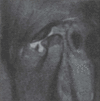Temporomandibular joint: from anatomy to internal derangement
- PMID: 37168044
- PMCID: PMC10165975
- DOI: 10.1590/0100-3984.2022.0072-en
Temporomandibular joint: from anatomy to internal derangement
Abstract
The temporomandibular joint can be affected by various conditions, such as joint dysfunction, degenerative changes, inflammatory processes, infections, tumors, and trauma. The aim of this pictorial essay is to help radiologists identify and describe the main findings on magnetic resonance imaging evaluation of the temporomandibular joint, given that the correct diagnosis is essential for the appropriate treatment of patients with temporomandibular joint disorders.
A articulação temporomandibular pode ser afetada por diversas afecções, como disfunções articulares, alterações degenerativas, doenças inflamatórias ou infecciosas, tumores e trauma. Este ensaio iconográfico visa auxiliar de forma prática o radiologista a identificar e descrever os principais achados nos exames de ressonância magnética da articulação temporomandibular, tendo em vista que o diagnóstico correto das alterações mais comuns é essencial para o tratamento adequado desses pacientes.
Keywords: Magnetic resonance imaging; Temporomandibular joint; Temporomandibular joint disorders; Temporomandibular joint dysfunction syndrome.
Figures











References
-
- Alomar X, Medrano J, Cabratosa J, et al. Anatomy of the temporomandibular joint. Semin Ultrasound CT MR. 2007;28:170–83. - PubMed
-
- Sommer OJ, Aigner F, Rudisch A, et al. Cross-sectional and functional imaging of the temporomandibular joint: radiology, pathology, and basic biomechanics of the jaw. Radiographics. 2003;23:e14–e14. - PubMed
-
- Tamimi D, Jalali E, Hatcher D. Temporomandibular joint imaging. Radiol Clin North Am. 2018;56:157–175. - PubMed
-
- Salamon NM, Casselman JW. Temporomandibular joint disorders: a pictorial review. Semin Musculoskelet Radiol. 2020;24:591–607. - PubMed
-
- Tamimi D, Kocasarac HD, Mardini S. Imaging of the temporomandibular joint. Semin Roentgenol. 2019;54:282–301. - PubMed
LinkOut - more resources
Full Text Sources
